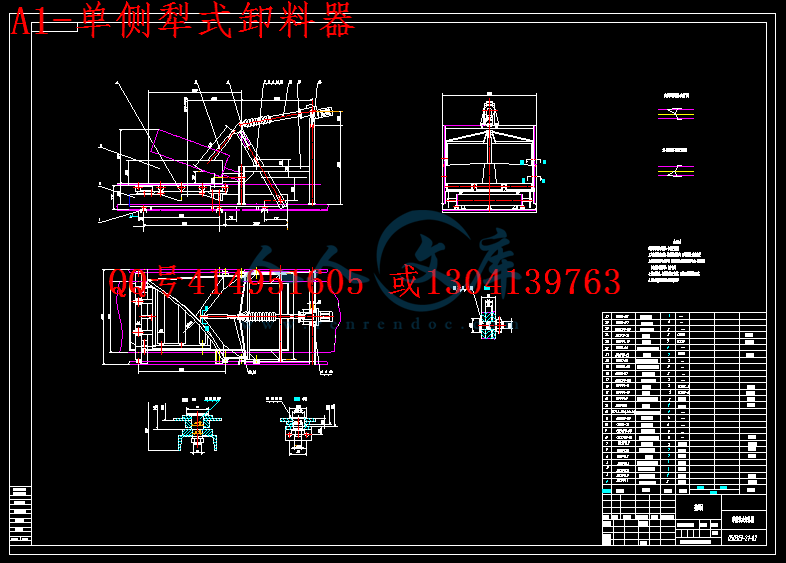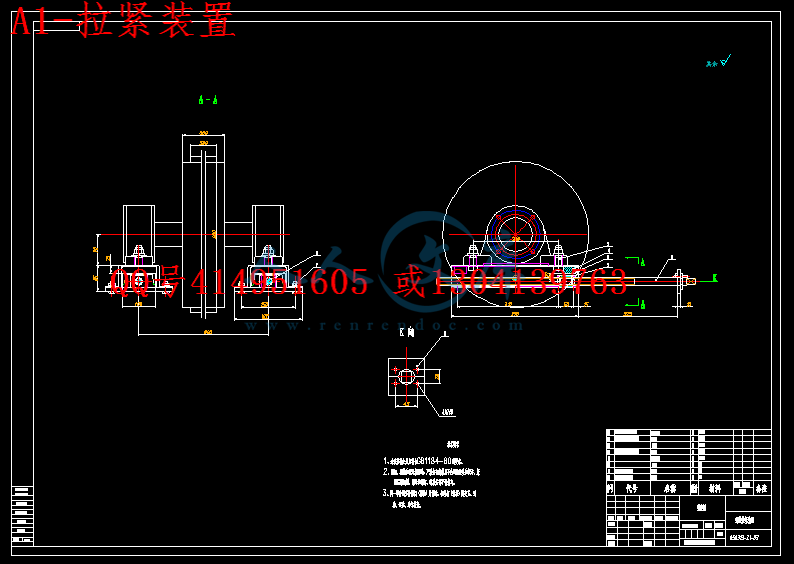【温馨提示】 购买原稿文件请充值后自助下载。
[全部文件] 那张截图中的文件为本资料所有内容,下载后即可获得。
预览截图请勿抄袭,原稿文件完整清晰,无水印,可编辑。
有疑问可以咨询QQ:414951605或1304139763
槽形托辊带式输送机设计
学生姓名:张锦卫 班级:050313
指导老师:封立耀
摘要:本文中概述了带式输送机的应用范围,分析了其工作原理和主要性能。对带式输送机的各个组成部件进行了详细的分析和选用。在设计中对输送机的主要部件进行了受力计算。并用Solidworks对连接轴进行有限元分析,使其强度达到要求。其后还对输送机的主要部件的作了寿命分析。
本文所设计的是槽形托辊带式输送机,其设计要求为:输送物料为原煤,输送量:80 吨/小时,输送长度:30 米,提升高度2米;堆积密度:900公斤/米3;物料在带面上的动堆积角为,输送带速:1.2米/秒,上托辊槽形布置。设计中,其整体是一个倾斜的状态,上托辊都采用槽形布置;下(回程)托辊采用平行托辊。本输送机为向下运输物料,其倾斜角为3.80<150,所以采用小倾角设计。在设计带宽时,按照槽形布置来选择计算。在尾架的选取方面,采用螺旋拉紧装置尾架,使输送带能始终保持必要的张力。用Solidworks对连接轴进行有限元分析,得出其一般工作时的性能状态,并做出相应的调整。
关键词: 槽形托辊 带式输送机 输送带 有限元分析
指导老师签名:
The Design of Slotted Roller Belt Conveyor
Student name: zhangjinwei Class: 050313
Supervisor: fengliyao
Abstract: This paper provides an overview of the scope of application of belt conveyor, an analysis of its working principle and main performance. The detailed analysis and selection are carried out on the various components of the conveyor components. In the design of the conveyor of the main components of the stress is calculated. In the design bandwidth, the calculation is carried out in accordance with the layout. And Solidworks is used to do the finite element analysis on the connecting axis. Subsequently it also analysis the main conveyor components’ life.
What is designed in this paper is slotted roller belt conveyor, the design requirements are: transport of materials: coal, transport capacity: 80 tons / hour, transmission length: 30 meters, 2 meters high upgrade; Bulk Density: 900 kg / m3; materials in the dynamic accumulation of the surface with angle, conveyor speed: 1.2 m / s, on the trough roller arrangement. Design of a tilt the overall state of the idler trough arrangement used; under the (return) the use of parallel idler rollers. When the materials are transport down through the conveyor, the tilt angle is 3.80 <150, so take the use of small-angle design. As the selection of the tailstock, we take the use of Tailstock screw tensioning device so that the conveyor system can always maintain the necessary tension. And Solidworks is used to do the finite element analysis on the connecting axis, to meet the required strength.
Keywords: slotted roller belt conveyor
conveyor idlers Finite Element Analysis
Signature of supervisor:
目 录
前言 ……………………………………………………………………………(6)
第一章 带式输送机 ………………………………………………………(7)
1 带式输送机的概述……………………………………………………(7)
1.1带式输送机的应用…………………………………………………………(7)
1.2带式输送机的工作原理 …………………………………………………(8)
1.3带式输送机的性能 ………………………………………………………(8)
1.4带式输送机的种类…………………………………………………………(9)
1.4.1 按承载能力分类………………………………………………………(9)
1.4.2 按可否移动分类………………………………………………………(9)
1.4.3 按输送带的结构形式分类……………………………………………(9)
1.5通用带式输送机的结构组成………………………………………………(10)
1.6 带式输送机的典型布置…………………………………………………(10)
2部件的选用………………………………………………………………(11)
2.1输送带………………………………………………………………………(11)
2.1.1 输送带的性能要求……………………………………………………(11)
2.2.2 输送带的选用…………………………………………………………(11)
2.2驱动装置…………………………………………………………………(14)
2.3传动滚筒……………………………………………………………………(15)
2.4托辊…………………………………………………………………………(16)
2.5机架…………………………………………………………………………(19)
2.6拉紧装置……………………………………………………………………(20)
2.6.1拉紧装置的作用…………………………………………………………(20)
2.6.2拉紧装置的结构形式……………………………………………………(20)
2.7 制动装置…………………………………………………………………(22)
2.7.1 逆止器…………………………………………………………………(22)
2.7.2 制动器…………………………………………………………………(23)
2.8 清扫器………………………………………………………………………(24)
2.8.1头部清扫器………………………………………………………………(24)
2.8.2 空段清扫器………………………………………………………………(25)
2.9 卸料装置及导料槽………………………………………………………(25)
2.9.1卸料装置………………………………………………………………(25)
2.9.2导料槽…………………………………………………………………(27)
第二章 槽形托辊带式输送机的计算…………………………………(28)
1 原始数据及工作条件…………………………………………………(28)
2 输送带选择计算…………………………………………………………(28)
2.1带宽………………………………………………………………………(28)
2.2每米胶带重…………………………………………………………………(29)
2.3输送带几何长度…………………………………………………………(29)
2.4输送带订货长度Ld(m)……………………………………………………(29)
3 输送能力的计算……………………………………………………………(30)
3.1输送带上物料流横截面面积S的计算………………………………………(30)
3.2.1重量生产率…………………………………………………………………(31)
3.2.2容积生产率…………………………………………………………………(31)
3.2.3件数生产率………………………………………………………………(31)
4 圆周驱动力和传动功率计算……………………………………………(32)
4.1圆周驱动力(N) Fu……………………………………………………………(32)
4.2主要阻力F…………………………………………………………………(32)
4.3主要特征阻力 ……………………………………………………………(33)
4.4附加特种阻力Fs……………………………………………………………(33)
4.5倾斜阻力Fst…………………………………………………………………(34)
4.6传动功率计算…………………………………………………………………(34)
5 张力计算 ………………………………………………………………………(35)
5.1限制输送带下垂度的最小张力:……………………………………………(35)
5.2各特性点张力(N) ……………………………………………………………(35)
5.3输送带工作时不打滑需保持的最小张力……………………………………(35)
5.4输送带层数Z ………………………………………………………………(36)
5.5输送带的强度校核…………………………………………………………(36)
5.6传动滚筒轴的强度计算和校核……………………………………………(36)
5.6.1传动滚筒的载荷集度……………………………………………………(37)
5.6.2传动滚筒扭矩M…………………………………………………………(37)
5.6.3抗弯截面系数W…………………………………………………………(37)
5.6.4滚筒轴的弯曲强度………………………………………………………(38)
5.7传动滚筒轴承的寿命计算…………………………………………………(38)
6托辊的选用计算…………………………………………………………(39)
7 拉紧行程S(m)…………………………………………………………(41)
第三章 用solidworks对连接轴进行有限元分析………………(41)
第四章 安装、试运行………………………………………………………(46)
1 安装…………………………………………………………………………(46)
1.1安装顺序……………………………………………………………………(46)
1.2安装注意事项………………………………………………………………(46)
2 试运转………………………………………………………………………(46)
2.1试运转前的检查……………………………………………………………(46)
2.2试运转期间的检查…………………………………………………………(46)
第五章 带式输送机皮带跑偏问题……………………………………(47)
第六章 安全操作和维护保养……………………………………………(51)
1 安全操作……………………………………………………………………(51)
2 维护保养……………………………………………………………………(51)
结 论…………………………………………………………………………(53)
参考文献…………………………………………………………………………(54)
致 谢…………………………………………………………………………(55)
前 言
带式输送机是重要的散状物输送设备。随着国民经济的发展,带式输送机的应用越来越广泛。它广泛应用于电力、冶金、化工、煤炭、矿山、建材、粮食等领域。带式输送机是利用摩擦力传递运动,以胶带、刚带、刚纤维带和化纤维带作为传送物料和牵引工件的一种适应能力强、应用广泛的连续输送机械。其特点是承载物料的带也是传递动力的牵引件,这是于其他输送机有着显著的区别。
我国生产制造的带式输送机的品种、类型都较多。产量多批次也相对的大,但其技术相对国外还是落后,特别是输送机的寿命和性能方面。带式输送机的技术水平有了很大提高,煤矿井下用大功率、长距离带式输送机的关键技术研究和新产品开发都取得了很大的进步。国外带式输送机技术的发展很快,其主要表现在以下两个方面:1、带式输送机的功能多元化、应用范围扩大化,如高倾角带输送机、管状带式输送机、空间转弯带式输送机等各种机型。2、带式输送机本身的技术与装备有了巨大的发展,尤其是长距离、大运量、高带速等大型带式输送机已成为发展的主要方向,其核心技术是开发应用于了带式输送机动态分析与监控技术,提高了带式输送机的运行性能和可靠性。
带式输送机是一类古老、经济适用而又现代化的输送机械。现在其发展趋向为:1. 继续向大型化发展。早在20世纪70年代,就已经出现了运输距离达到100km的带式输送机输送线路。近年来,带式输送机在矿山运输中已经逐渐开始取代汽车和机车运输,成为散状物料输送的主要装备。2. 扩大输送机的使用范围。发展能在高温、低温条件下、有腐蚀性、放射性、易燃性物质的环境中工作的,以及能输送炽热、易爆、易结团、粘性的物料的输送机。3.使输送机的构造满足物料搬运系统自动化控制对单机提出的要求。如邮局所用的自动分拣包裹的小车式输送机应能满足分拣动作的要求等。
带式输送机结构简单、运行可靠、输送量大、输送物料广、装、卸比较方便等优点,所以在各行各业中得到广泛应用,尤其在煤矿生产中发挥着巨大作用。所以本次毕业设计我选的题目是槽形托辊带式输送机。我想对槽形托辊带式输送机的设计还是很有其必要的。
第一章带式输送机
1 带式输送机的概述
1.1带式输送机的应用
带式输送机是一种摩擦驱动以连续方式运输物料的机械。应用它,可以将物料在一定的输送线上,从最初的供料点到最终的卸料点间形成一种物料的输送流程。它既可以进行碎散物料的输送,也可以进行成件物品的输送。除进行纯粹的物料输送外,还可以与各工业企业生产流程中的工艺过程的要求相配合,形成有节奏的流水作业运输线。所以带式输送机广泛应用于现代化的各种工业企业中。
( 1 ) DTⅡ互型固定式带式输送机是通用型系列产品,可广泛用于冶金、矿山、煤炭、港口、电站、建材、化工、轻工、石油等各个行业。由单机或多机组合成运输系统来输送物料,可输送松散密度为500 -- 2500kg / ,的各种散状物料及成件物品。
( 2 ) DTⅡ 江型固定式带式输送机适用的工作环境温度一般为-25 ~40 ℃ 。对于在特殊环境中工作的带式输送机,如要求具有耐热、耐寒、防水、防腐、防爆、阻燃等条件,应另行采取相应的防护措施。
( 3 ) DTⅡ型固定式带式输送机均按部件系列进行设计。设计者可根据输送工艺要求,按不同的地形、工况进行选型设计并组合成整台输送机。
( 4 )输送机允许输送的物料粒度取决于带宽、带速、槽角和倾角,也取决于大块物料出现的频率。各种带宽适用的最大粒度,本系列推荐按表2 一1 选取。当输送硬岩时,带宽超过1200mm 后,粒度一般应限制在350mm 范围内,而不能随带宽的增加而加大。
表1-1 各种带宽适用的最大粒度 mm
带宽 500 650 800 1000 1200 1400 1600 1800 2000 2200 2400
最大粒度 100 150 200 300 350 350 350 350 350 350 350
注:粒度尺寸系指物料块最大线性尺寸.
1.2带式输送机的工作原理
带式输送机其主要部件是输送带,亦称为胶带,输送带兼作牵引机构和承载机构。带式输送机组成主要包括以下几个部分:输送带(通常称为胶带) 、托辊及中间架、滚筒拉紧装置、制动装置、清扫装置和卸料装置等。 输送带绕经传动滚筒和机尾换向滚筒形成一个无极的环形带。输送带的上、下两部分都支承在托辊上。拉紧装置给输送带以正常运转所需要的拉紧力。工作时,传动滚筒通过它和输送带之间的摩擦力带动输送带运行。物料从装载点装到输送带上,形成连续运动的物流,在卸载点卸载。一般物料是装载到上带(承载段)的上面,在机头滚筒(在此,即是传动滚筒)卸载,利用专门的卸载装置也可在中间卸载。
1.3带式输送机的性能
1 输送物料种类广泛
输送物料的范围可以从很细的各种粉状物料到大块的矿石、石块、煤或纸浆木料,以最小的落差输送精细筛分过的或易碎的物料。由于橡胶输送带具有较高的抗腐蚀性,在输送强腐蚀性或强磨损性物料时维修费用比较低。带式输送机还可以输送碱性物料和一定温度热料,也可以运送成件物品。
2 输送能力范围宽
带式输送机的输送能力可以满足任何要求的输送任务,既有轻型带式输送机完成输送量较小的输送任务,又有大型带式输送机实现每小时数千吨的输送任务。
3 输送统一线路的适应性强
带式输送机可以适应坡度为30%~35%的地形,而对于卡车运输来说公能适应原有自然地形的坡度为6%~8%。输送机线路可以适应地形, 在空间和水平面上弯曲从而降低基建投资,并能避免在厂内和其他拥挤地区,以免受铁路、公路、以及河流、山脉的干扰。带式输送机的运输线路十分灵活的,线路长度可根据需要延长。
4 灵活的装卸料
带式输送机可根据工艺流程要求灵活地从一点或多点受料,也可以向多点或几个区段卸料。
5 可靠性强
带式输送机的可靠性已成为所有工业领域中的使用经验所证实,它的运行极为可靠,在许多需要连续运行的重要生产单位,如在发电厂内煤的输送,钢铁厂和水泥厂散物料的输送以及港口内船舶装卸散状物料 等,都获得了广泛的应用。
6 安全性高
带式输送机具有很高的安全性,需要的生产人员很少,与其他运输方式相比发生事故的机会比较少。不会因大块物料掉下来砸伤人员或由于大型笨重的车辆操纵失灵而引起事故。
7 费用低
带式输送机系统运送每吨散状物料所需的劳动工时和能耗,在所有运输散状物料工具中通常是最低的。而且它所占用维修人员的时间少,较小零件的维修和更换可在现场很快地完成,维修费用低。
1.4带式输送机的种类
1.4.1 按承载能力分类
轻型带式输送机:专门应用于轻型载荷的输送机。
通用带式输送机:这是应用最广泛的带式输送机,其他类型带式输送机都是这种带式输送机的变形。
钢绳芯带式输送机:应用于重型载荷的输送机。
1.4.2 按可否移动分类
固定带式输送机:输送机安装在固定的地点,不需要移动。
移动带式输送机:具有移动机构,如轮,履带。
移置带式输送机:通过移动设备变换设备的位置。
可伸缩带式输送机:通过储带装置改变输送机的长度。
1.4.3 按输送带的结构形式分类
普通输送带带式输送机:输送带为平型,带芯为帆布或尼龙帆布或钢绳芯。
钢绳牵引带式输送机:用钢丝绳作为牵引机构,用带有耳边的输送带作为承载机构。
压带式输送机:用两条闭环带,其中一条为承载带,另一条为压带。
钢带输送机:输送带是钢带。
网带输送机:输送带是网带。
管状带式输送机:输送带围包成管状或用特殊结构输送带密闭输送物料。
波状挡边带式输送机:输送带边上有挡边以增大物料的截面,倾斜角度大时,一般在横抽设置挡板。
花纺带式输送机:用花纹带以增大物料和输送带的摩擦,提高输送倾角。
1.5通用带式输送机的结构组成







 川公网安备: 51019002004831号
川公网安备: 51019002004831号